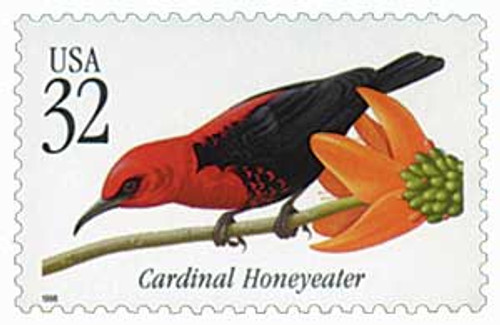
1998 32c Green-throated Carib Tropical Bird
# 3223 - 1998 32c Green-throated Carib Tropical Bird
$1.00 - $3.20
U.S. #3222
1998 32¢ Green-throated Carib
Tropical Birds
1998 32¢ Green-throated Carib
Tropical Birds
Issue Date: July 29, 1998
City: Ponce, Puerto Rico
Quantity: 17,500,000
Printed By: Banknote Corporation of America
Printing Method: Lithographed
Perforations: 11.2
Color: Multicolored
City: Ponce, Puerto Rico
Quantity: 17,500,000
Printed By: Banknote Corporation of America
Printing Method: Lithographed
Perforations: 11.2
Color: Multicolored
This issue is part of a four-stamp se-tenant featuring tropical birds that are native to the islands belonging to the United States. The Antillean Euphonia resides in the thick mountain forests of Puerto Rico. The Green-throated Carib is also found in Puerto Rico, but along the northeast coast. The Crested Honeycreeper is an endangered species from the rain forests of Maui, and the Cardinal Honeyeater lives on the South Pacific island of Samoa.
A member of the hummingbird family Trochilidae, the green-throated carib can be found on the northeast coast of Puerto Rico. Birds of this group are among the world’s smallest and most beautifully colored. Many were named according to their bright plumage, including the carib.
The carib’s bill is long and curved downward to allow the bird to extract nectar from flowers. Its few feathers look scale-like and iridescent. On many birds, these shiny colors appear to be arranged in patterns. The metallic brilliance and variety of tints of hummingbird plumage is unrivaled by any other group of birds.
In addition to the humming noise created by the beating of their wings, the birds also make a variety of vocal sounds. Considered the fastest of all birds, the smallest of hummingbirds can beat their wings 50 times each second. That number decreases in proportion to size. They can also hover and remain stationary in the air, and are the only birds who can fly backwards.
Because of their high metabolism rate, caribs spend the daylight hours darting around, restlessly searching for food. At night, they perch quietly on a twig. Bold and aggressive, the caribs live a mostly solitary existence, rarely tolerating intruders.
U.S. #3222
1998 32¢ Green-throated Carib
Tropical Birds
1998 32¢ Green-throated Carib
Tropical Birds
Issue Date: July 29, 1998
City: Ponce, Puerto Rico
Quantity: 17,500,000
Printed By: Banknote Corporation of America
Printing Method: Lithographed
Perforations: 11.2
Color: Multicolored
City: Ponce, Puerto Rico
Quantity: 17,500,000
Printed By: Banknote Corporation of America
Printing Method: Lithographed
Perforations: 11.2
Color: Multicolored
This issue is part of a four-stamp se-tenant featuring tropical birds that are native to the islands belonging to the United States. The Antillean Euphonia resides in the thick mountain forests of Puerto Rico. The Green-throated Carib is also found in Puerto Rico, but along the northeast coast. The Crested Honeycreeper is an endangered species from the rain forests of Maui, and the Cardinal Honeyeater lives on the South Pacific island of Samoa.
A member of the hummingbird family Trochilidae, the green-throated carib can be found on the northeast coast of Puerto Rico. Birds of this group are among the world’s smallest and most beautifully colored. Many were named according to their bright plumage, including the carib.
The carib’s bill is long and curved downward to allow the bird to extract nectar from flowers. Its few feathers look scale-like and iridescent. On many birds, these shiny colors appear to be arranged in patterns. The metallic brilliance and variety of tints of hummingbird plumage is unrivaled by any other group of birds.
In addition to the humming noise created by the beating of their wings, the birds also make a variety of vocal sounds. Considered the fastest of all birds, the smallest of hummingbirds can beat their wings 50 times each second. That number decreases in proportion to size. They can also hover and remain stationary in the air, and are the only birds who can fly backwards.
Because of their high metabolism rate, caribs spend the daylight hours darting around, restlessly searching for food. At night, they perch quietly on a twig. Bold and aggressive, the caribs live a mostly solitary existence, rarely tolerating intruders.












